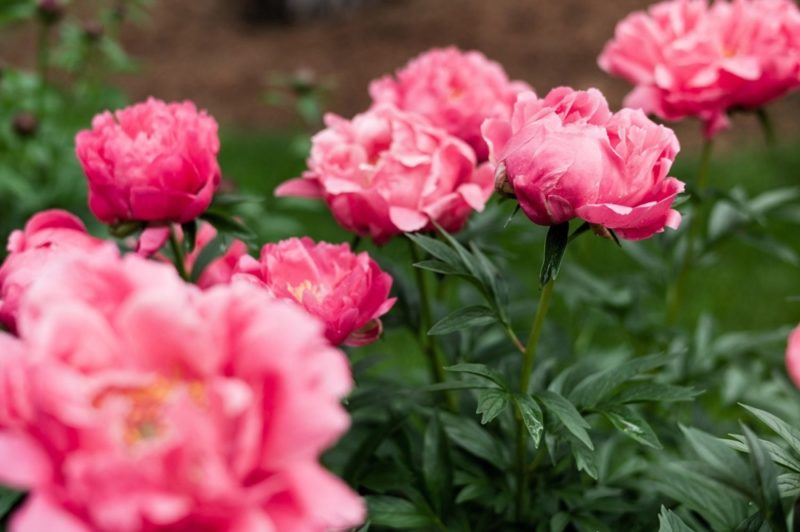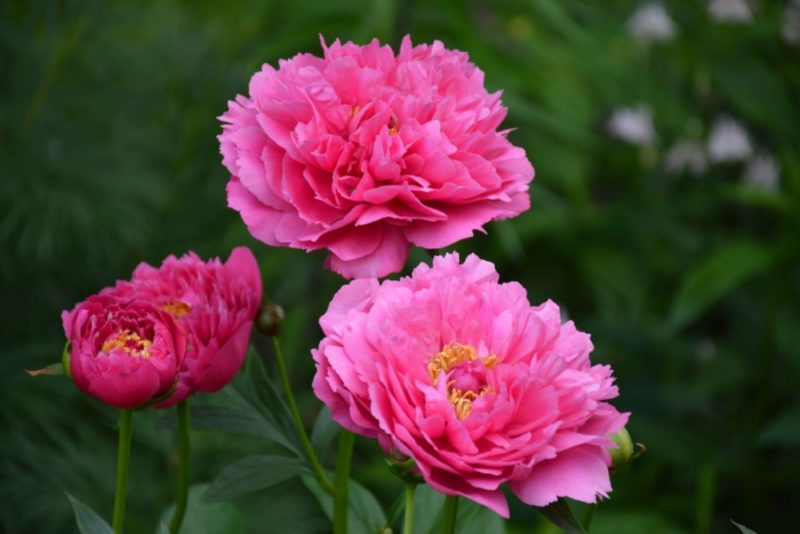Among hundreds of diverse cultures, many gardeners choose peonies to decorate the site. Their amazing aroma and amazingly beautiful flowers conquer the heart of anyone who at least once had the good fortune of being acquainted with them. Grassy peony is as luxurious as a rose, but less demanding in care.
Material Content:
Description of the best varieties of grassy peony
The best varieties of grassy peonies are represented by bush species of different heights with a varied color of petals and openwork foliage.
- Canadian hybrid "Henry Boxtos" is distinguished by stems up to 90 cm in height and semi-double flowers of a pink form. The petals are dark red, the buds are very dense and stuffed. This variety is resistant to diseases, tolerates winter well.
- "Sarah Bernhardt" is a classic representative of grassy peonies. It blooms very plentifully and long in the late stages. The foliage is dark, and the shoots are very powerful. The bushes look decorative until late autumn, and during flowering, the plant strikes with the beauty of double flowers with reddish strokes of pale pink. The variety is distinguished by winter hardiness, endurance.
- "Maxim Festival" - a variety of French selection. Flowering in the medium term. It has a faint, very pleasant aroma. The center of the flower is light scarlet. The variety is distinguished by terry, abundant flowering, very long.
- Coral Sunset is an American hybrid. The buds are semi-double, large. Very resistant to disease. The color of the buds is very bright, coral.
There are so many varieties of grassy peonies, and each of them is beautiful in its own way.
Important nuances of growing
A flower needs a lot of light. This is the main nuance that you should pay attention to when choosing a site.Although a peony can come to terms with partial shade, still the best place for it is in the sun.
If the plant does not have enough sunlight, this will certainly affect the number of flowers and their size.
It is advisable to plant bushes in sheltered and warm places. Although the new varieties have strong shoots, they can still be broken by a strong wind. Peonies are planted a little remotely from other large plants and buildings, because they need plenty of light and space.
Grassy peony soil loves fertile. Loam is great. The soil reaction should be slightly alkaline. Although this plant may come to terms with slightly acidic soil, it is still advisable to add some lime before planting.
"Wet" areas for such flowering bushes are not suitable. Not the best solution and sites on which snow melts for a long time in spring.
Outdoor landing
Planting of grassy peonies begins with the preparation of the selected site. First, the earth is dug up deeply, and then organic matter is introduced. A well-ripened compost will do. This crop does not tolerate manure.
You can manually prepare the soil mixture to fill the planting pits.
This requires:
- Mix the soil extracted from the dug hole in equal parts with ripened compost, add peat and sand. Mineral fertilizers are also added to the soil mixture.
- Fill the planting hole with soil from garden soil and peat with the addition of superphosphate (0.2 - 0.25 kg).
Given the volume of the root system, a planting hole is dug up as for an adult bush - at least 70x70 cm. The step between copies is kept at one meter.
- In a wet area, a layer of 20 cm of drainage is laid at the bottom of the hole.
- First, the hole is filled with prepared soil, and then a peony is planted. Culture really does not like transplants, so instances should be planted carefully.The decisive role is played by the correct peony planting depth. Make sure the kidneys are a couple of centimeters below the ground.
- Complete the process with abundant watering.
- It will also be useful to mulch the soil around the young bush, which will reduce moisture evaporation.
Plant care
Peonies are distinguished by resistance to harsh conditions and unpretentiousness, the culture requires a minimum of care. In fact, for the entire season, it is necessary to water the bushes only twice. At the end of June, you need to moisten the plants to help them form buds. The second time the bushes are poured in late summer so that they build up the root system.
Watering at the stage of budding and flowering is desirable, but they are optional in the middle lane.
Peonies will delight in the beauty of fragrant buds without transplantation for decades. But the quality of flowering after about 10 years after planting is getting worse. To stimulate the plant to grow, regularly divide bushes. This is done every 5 to 7 years at the end of summer.
Varieties with large inflorescences should be tied up. On sale there are special supports that are installed on the bush.
Wilted inflorescences cut. You can’t leave faded buds, as they increase the risk of diseases. If you need to collect seeds, leave only a couple of flowers. On the bushes younger than two years, you can not leave buds. They are also removed.
A mandatory measure is winter pruning. When steady night cold sets in, they remove the entire aerial part, leaving small stumps of 4 cm. The remains of the bush are sprinkled with ash.
Flowering crops will be grateful to the owner for competent dressing:
- At the beginning of growth, in the early spring, nitrogen is introduced under the peonies. This will stimulate the rapid growth of shoots.
- Then the bushes are fed at the time of budding with mineral complexes.
- At peak flowering, additional nutrition is also needed. At this time, phosphorus-potassium compounds are added.
Weeding and mulching are also needed in peony care. The soil after watering must be loosened.
When you can transplant beautiful flowering perennials.
These perennial garden flowers are transplanted in spring and autumn. The procedure can be combined with the separation of the rhizome. Bushes require rejuvenation. Although peonies can grow in one place for up to 30 years, it is still advisable to plant them.
If you just need to move the bush to a new place, the procedure is done by digging a plant together with a clod of earth around the roots and transferring it to a new landing pit.
Propagation of garden flowers
These beautiful flowering perennials are propagated both by seeds and vegetatively.
The easiest way to get new plants that will retain all varietal traits, when dividing the bush.
Only peonies that have a minimum of 7 shoots and flowering “experience” of 3 to 4 years can be divided.
The best time is the end of summer. They dig it out very carefully, since the rhizome of peonies is fragile. First, a bush is dug up, and then removed with a shovel or pitchfork.
The soil is gently shaken from the rhizome, and then it is divided with a knife into several pieces. They are planted according to the same rules as the planting of a peony as a whole.
Reproduction by seeds is mainly used in breeding. In private homes, this method is too rare. Crops of seeds are produced before winter. Such peonies bloom only in the fifth year.
Winter preparations
Preparing flowers for the winter is necessary, even despite the fact that peonies are winter-hardy plants. At least light shelter is needed to help the roots survive the frost. Peony is very dangerous for peonies, therefore foliage cannot be used for this purpose. It is best to put a layer of 7 cm mulch from compost or peat on the bushes. But this is only necessary for young plants. Adult specimens can be completely hidden.
In spring, as soon as the snow melts, the shelter should not be removed until red shoots appear. The procedure is carried out extremely carefully so as not to damage the delicate shoots.
Diseases, pests and methods of dealing with them
Particularly common is gray rot on peonies. Spotting and root rot are not so rare. Sometimes peonies get rust. Even the slightest deviations in soil density and acid reaction can cause the rapid development of the disease.
For weak varieties with low resistance to pathogens, prophylaxis is necessary. It is enough to spray the bushes in spring with copper sulfate. Rust is treated with Bordeaux liquid. Against powdery mildew, colloidal sulfur must be used.
To protect the flowers from damage by diseases, as well as cure if the plants become infected, you should spray them with fungicides. The fight against the disease is a lengthy process that requires multiple treatments of the bush. In the future, regular preventive measures should be taken.
Parasites on peonies, mainly aphids and ants. Other pests are rare. Insecticides are used against them, following the instructions.
Use in landscape design
The magnificent, noble peony simply amazingly looks at water bodies during flowering. Flowers are reflected in the water, turning the landscape of the garden into a picture. A variety of shades of flowers allows you to create stunning floral arrangements from these luxurious plants, combining them with other inhabitants of the garden. Peony looks romantic at the entrance to the house or next to the gazebo or terrace.
Peonies often overshadow the neighboring flowers with their luxury. Therefore, many flower growers are afraid to put them in mixborders. In this case, you can create a flower garden group. You can plant several perennials on one flower bed, contrasting with each other.
Great decoration for peonies - delicate crocuses and tulips. Looks great next door iris, daffodil. Peonies often plant along the paths or plant them all the way around the site. These proud plants can be combined with daylilies, godetia and petunias.
Lush flowering peonies look amazing against the background of lawns or evergreen conifers. Their juicy greens shade the brightness of the colors of inflorescences.
When composing the composition, one should not forget that even after flowering, the peony looks very decorative, and its juicy greens can serve as an excellent background for many flowering plants.
Growing peonies is a grateful, fascinating activity that can become a hobby for life. These flowers are very unpretentious, rarely sick and practically do not require care. But the peony will not forgive the complete lack of attention.





















